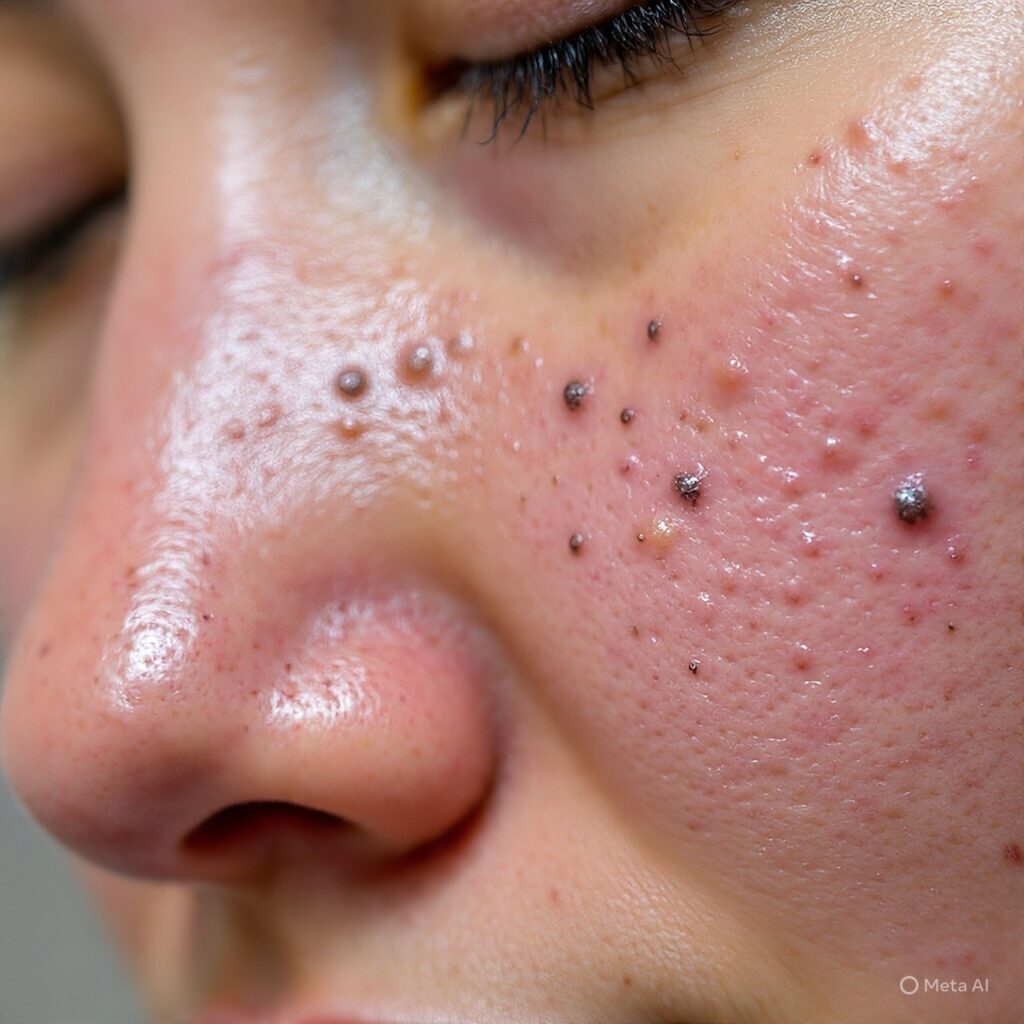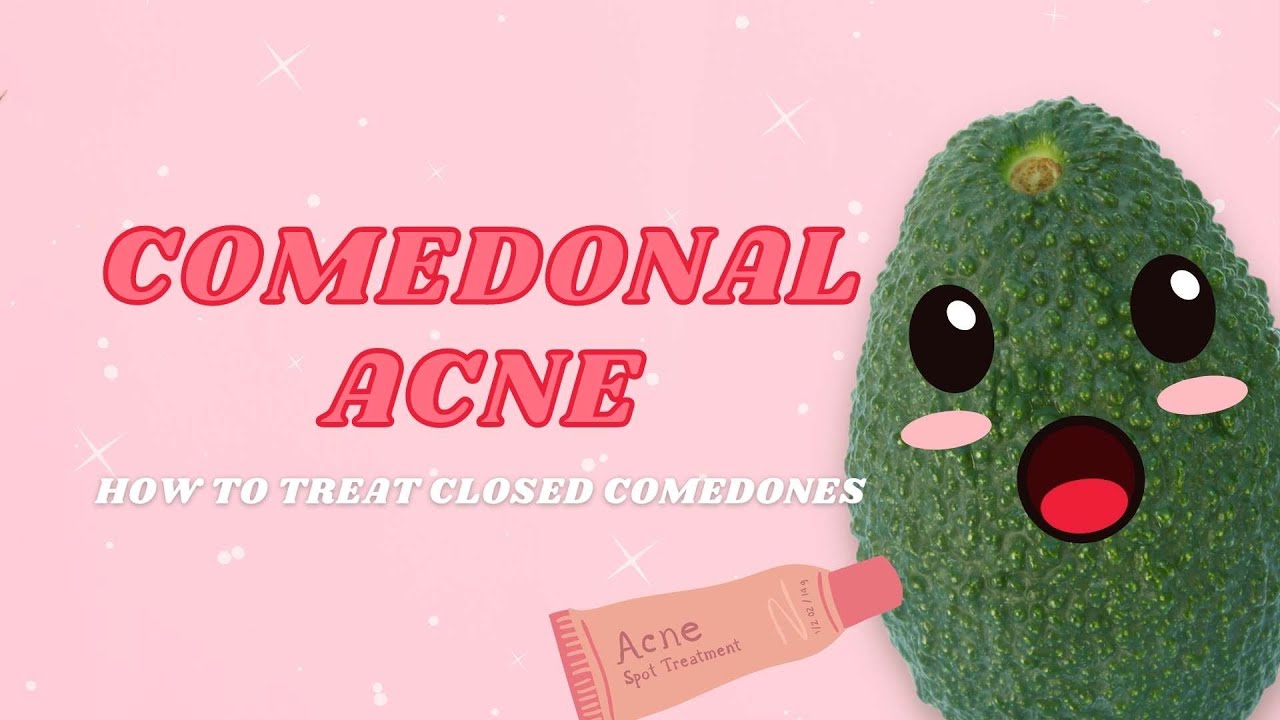“Say a big NO to Comedones! An insight into these common skin issues – blackheads and whiteheads – along with practical natural tips to achieve a healthier complexion.”
What Are Comedones?
Comedones are a type of skin lesion commonly associated with acne. They are small, non-inflammatory bumps that form when hair follicles become clogged with dead skin cells, sebum (natural oil), and sometimes bacteria. Comedones can be open or closed, and they come in two main types:
Types Of Comedones
Open Comedones (Blackheads):
Open comedones are also known as blackheads. They appear as small, dark spots on the skin’s surface. The dark color is not due to dirt but rather the oxidation of melanin (skin pigment) when exposed to air.
Closed Comedones (Whiteheads):
Closed comedones are small, flesh-colored or slightly raised bumps that are covered by a thin layer of skin. They may appear as white or skin-colored dots on the skin’s surface.
Comedones are a common feature of acne-prone skin and can be a precursor to other types of acne lesions, such as papules, pustules, and nodules. While they are not typically inflamed or painful on their own, if bacteria become trapped within the comedones, they can lead to inflammation and the formation of more severe types of acne.
What Comedones Look Like
Here’s how each type looks:
Open Comedones (Blackheads):

Blackheads are small, dark or black spots on the skin’s surface. They are open at the top, allowing air to enter the pore. The dark color is not due to dirt but rather the oxidation of melanin (skin pigment) when exposed to air. Blackheads may appear slightly raised and can be more noticeable on the skin, especially in areas with larger pores, such as the nose, chin, and forehead.
Closed Comedones (Whiteheads):

Whiteheads are small, flesh-colored or white bumps that are covered by a thin layer of skin. Unlike blackheads, whiteheads are closed at the top, which prevents air from entering the pore. This lack of exposure to air prevents oxidation, so they don’t have the dark appearance of blackheads. Whiteheads are typically not as raised or noticeable as blackheads and may feel slightly rough to the touch.
Both types of comedones can be found on various parts of the face, back, chest, and shoulders – areas where hair follicles are more abundant. While comedones themselves are not usually painful or inflamed, they can be a precursor to more severe forms of acne if bacteria become trapped within them, leading to inflammation and the development of red, swollen pimples. Proper skincare and regular cleansing can help prevent and manage comedones. If you have concerns about comedones or acne, consider consulting a dermatologist for personalized advice and recommendations.
What Causes Comedones?
Comedones, both open (blackheads) and closed (whiteheads), are primarily caused by the clogging of hair follicles. The main contributing factors include:
Excess Sebum Production:
Sebum is the natural oil produced by your skin to keep it moisturized. Excess sebum production can lead to the accumulation of oil within the hair follicles, contributing to clogged pores.
Dead Skin Cells:
As the skin’s outermost layer sheds dead skin cells, these cells can mix with sebum and become trapped in the hair follicles, obstructing their openings.
Hormonal Changes:
Hormonal fluctuations, especially during puberty, menstruation, pregnancy, and times of increased androgen production, can lead to higher sebum production, making individuals more prone to comedone formation.
Cosmetics and Skincare Products:
Certain makeup and skincare products that are heavy or pore-clogging can contribute to the development of comedones, particularly if they are not thoroughly removed from the skin.
Diet and Lifestyle:
Consuming a diet high in refined sugars and carbohydrates can potentially impact sebum production and skin health, contributing to comedone formation. Additionally, certain lifestyle factors like smoking and stress might influence skin condition.
Genetics:
A genetic predisposition to having larger pores, higher sebum production, or a tendency to develop clogged pores can make some individuals more susceptible to comedone formation.
Humidity and Environment:
High humidity can increase the stickiness of sebum and dead skin cells, making it easier for them to clog pores. Environmental factors, such as pollution and exposure to dirt, can also contribute to pore congestion.
Improper Skincare:
Not properly cleansing your face or using products that are too harsh can disrupt the skin’s natural balance and contribute to the accumulation of debris within the pores.
How To Treat Comedones
Topical Treatment:
Treating comedones topically involves using skincare products that help to exfoliate the skin, unclog pores, and regulate sebum production. Here are some steps and ingredients that can be effective in treating comedones:
1. Cleansing:
Start with a gentle cleanser to remove dirt, oil, and makeup from your skin. Look for a cleanser that is suitable for your skin type and doesn’t strip away too much natural oil.
2. Exfoliation:
Exfoliating products help remove dead skin cells and prevent them from clogging pores. There are two main types of exfoliants:
3. Chemical Exfoliants:
These contain alpha hydroxy acids (AHAs) like glycolic acid and lactic acid, or beta hydroxy acids (BHAs) like salicylic acid. BHAs are particularly effective for treating comedones as they penetrate the pores and help dissolve excess sebum and debris.
4. Physical Exfoliants:
These contain small particles that physically scrub away dead skin cells. However, be cautious with physical exfoliants, as they can sometimes be too abrasive and worsen inflammation.
5. Retinoids:
Topical retinoids, such as retinol or prescription-strength tretinoin, are derived from vitamin A and are known to increase cell turnover, prevent clogged pores, and reduce inflammation. They can be effective in treating both open and closed comedones.
6. Salicylic Acid:
This beta hydroxy acid is oil-soluble and can penetrate the pores to exfoliate the inside of the follicles, making it particularly useful for treating blackheads and whiteheads.
7. Benzoyl Peroxide:
This ingredient can help reduce the amount of bacteria on the skin and is effective in treating inflammatory acne, which can develop from clogged comedones.
8. Niacinamide:
Also known as vitamin B3, niacinamide helps regulate sebum production and has anti-inflammatory properties that can benefit both open and closed comedones.
19. Moisturizer:
Even if you have oily or acne-prone skin, it’s important to use a lightweight, non-comedogenic moisturizer to keep your skin hydrated without clogging pores.
10. Sunscreen:
Protect your skin from the sun’s harmful rays by using a broad-spectrum sunscreen with at least SPF 30. Some acne treatments can make your skin more sensitive to the sun.
Medical Treatment:
Treating comedones with medications often involves using prescription-strength products that can effectively target clogged pores and regulate oil production. Here are some medications commonly used to treat comedones:
1. Topical Retinoids:
These are prescription medications derived from vitamin A that help increase cell turnover, prevent clogged pores, and reduce inflammation. Examples include tretinoin, adapalene, and tazarotene. They can be particularly effective in treating both open and closed comedones. Topical retinoids can cause initial irritation, so it’s important to start with a lower concentration and gradually increase as your skin adjusts.
2. Topical Antibiotics:
Antibiotic creams or gels, such as clindamycin or erythromycin, can be prescribed to reduce inflammation and control the growth of bacteria on the skin’s surface. They are often used in combination with other treatments to address inflamed comedones.
3. Oral Antibiotics:
For more severe cases, oral antibiotics like doxycycline or minocycline may be prescribed to reduce bacteria and inflammation. They are typically used for a limited time due to concerns about antibiotic resistance.
4. Combination Therapy:
Some medications combine multiple active ingredients, such as a topical retinoid and an antibiotic, to address both clogged pores and inflammation.
5. Oral Contraceptives:
For females, hormonal birth control pills can be effective in regulating hormone levels that contribute to excessive oil production and clogged pores. Certain types of birth control can help improve acne and comedone symptoms.
6. Isotretinoin:
This powerful oral medication, also known as Accutane, is typically used for severe acne that doesn’t respond to other treatments. It works by reducing sebum production and shrinking oil glands. Isotretinoin is associated with potential side effects and requires close monitoring by a healthcare provider.
7. Hormone Therapy:
In some cases, hormone therapy with medications like spironolactone can be prescribed to help regulate excess oil production, especially for those with hormonal imbalances contributing to comedones.
It’s important to note that prescription medications should be used under the guidance and supervision of a dermatologist or healthcare professional. They can assess your specific situation, recommend the most appropriate treatment, and monitor your progress while managing any potential side effects. Additionally, it may take several weeks to see noticeable improvements with these medications, so patience is key in the treatment process.
Comedones Treatment At Home
Treating comedones naturally at home involves using gentle, non-prescription methods to help unclog pores, reduce inflammation, and promote healthier skin. Keep in mind that natural remedies might work differently for each individual, and consistency is key.
Here are some home remedies to consider:
Steam:
Gently steaming your face can help open up pores and soften the skin, making it easier to remove debris. Be cautious not to use water that is too hot, and avoid steaming for extended periods to prevent skin irritation.
Honey:
Honey has natural antibacterial properties and can help soothe inflammation. Apply a thin layer of raw honey to your face, leave it on for about 15-20 minutes, and then rinse off.
Clay Masks:
Bentonite clay or kaolin clay masks can help draw out impurities from the pores. Mix the clay with water or aloe vera gel to create a paste, apply it to your face, and rinse off once it’s dry.
Charcoal powder also works wonders on the skin to treat comedones.
Tea Tree Oil:
Tea tree oil has antibacterial and anti-inflammatory properties. Dilute a few drops of tea tree oil with a carrier oil (like jojoba oil) and apply it to affected areas. Make sure to do a patch test first, as tea tree oil can be irritating to some skin types.
Exfoliation:
Use gentle exfoliating ingredients, like oatmeal or ground rice, to create a homemade scrub. Gently massage the scrub onto your skin in circular motions to help remove dead skin cells and unclog pores.
Apple Cider Vinegar:
Diluted apple cider vinegar can act as a natural toner. Mix equal parts of apple cider vinegar and water, apply it with a cotton pad, and let it dry before rinsing off. It’s important to patch test first and avoid using it undiluted, as it can be harsh on the skin.
Aloe Vera:
Aloe vera has soothing and anti-inflammatory properties. Apply pure aloe vera gel to your skin and leave it on for about 15-20 minutes before rinsing off.
Oil Cleansing:
Using oils like jojoba, grapeseed, or argan oil for oil cleansing can help dissolve excess sebum and unclog pores. Gently massage the oil onto your face and use a warm, damp cloth to wipe it off.
Hydration and Diet:
Drinking plenty of water and maintaining a balanced diet rich in fruits, vegetables, and whole foods can support overall skin health.
Avoid Over-Cleansing:
While it’s important to keep your skin clean, over-cleansing can strip away natural oils and worsen the issue. Stick to a gentle cleansing routine.
Remember that not all natural remedies are suitable for every skin type, and individual responses can vary. If you have sensitive skin or existing skin conditions, it’s wise to consult with a dermatologist before trying any new home remedies. Additionally, if your comedones are persistent or severe, professional medical guidance might be necessary for effective treatment.




